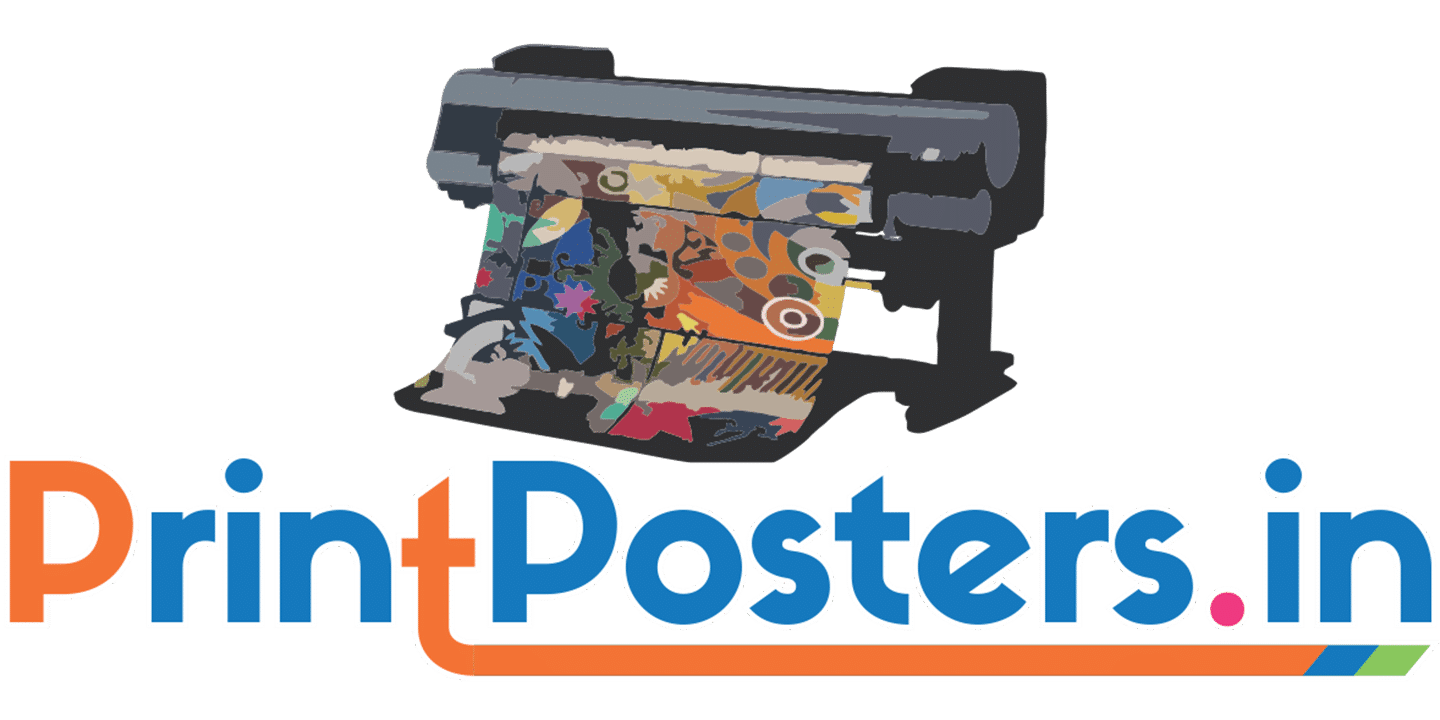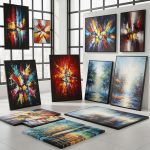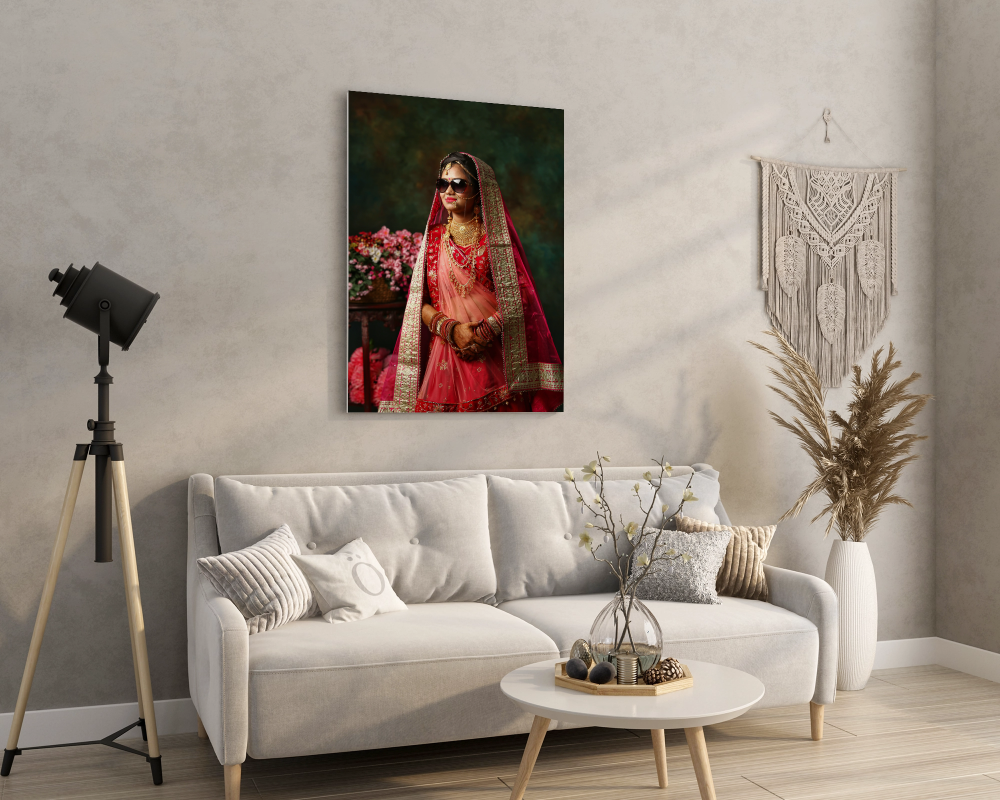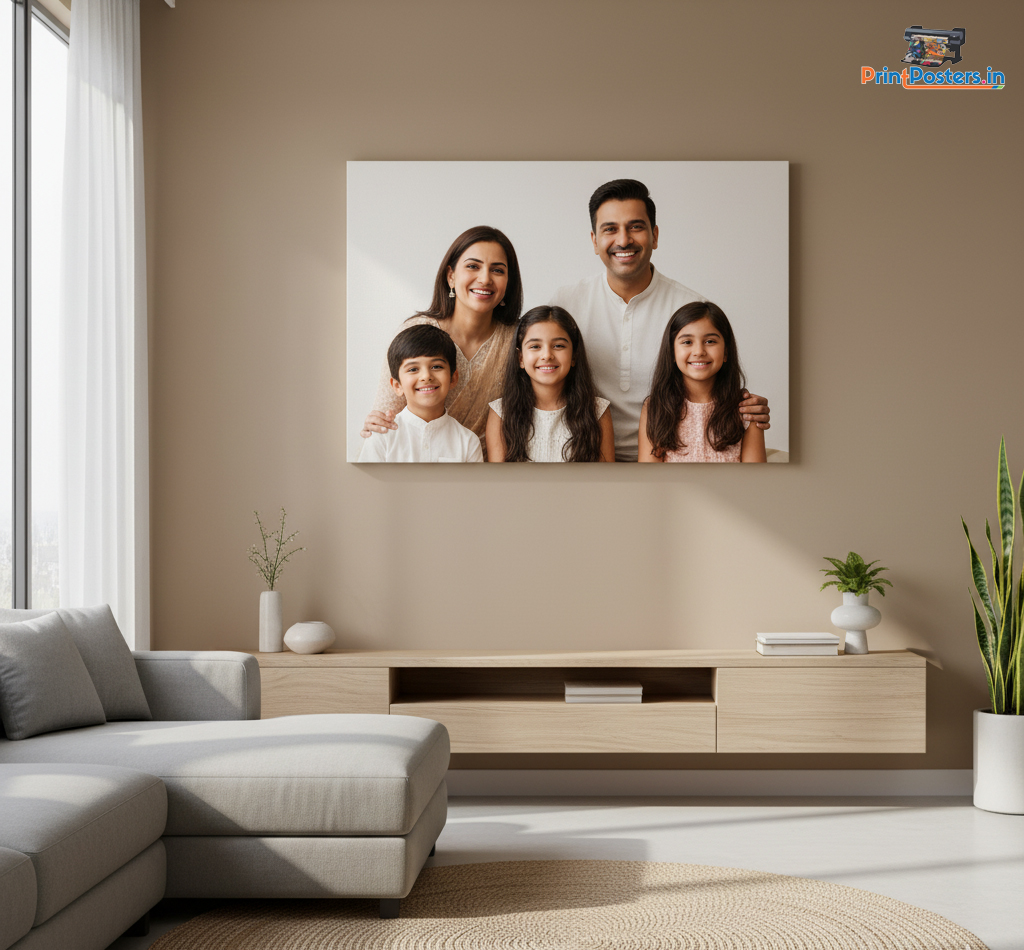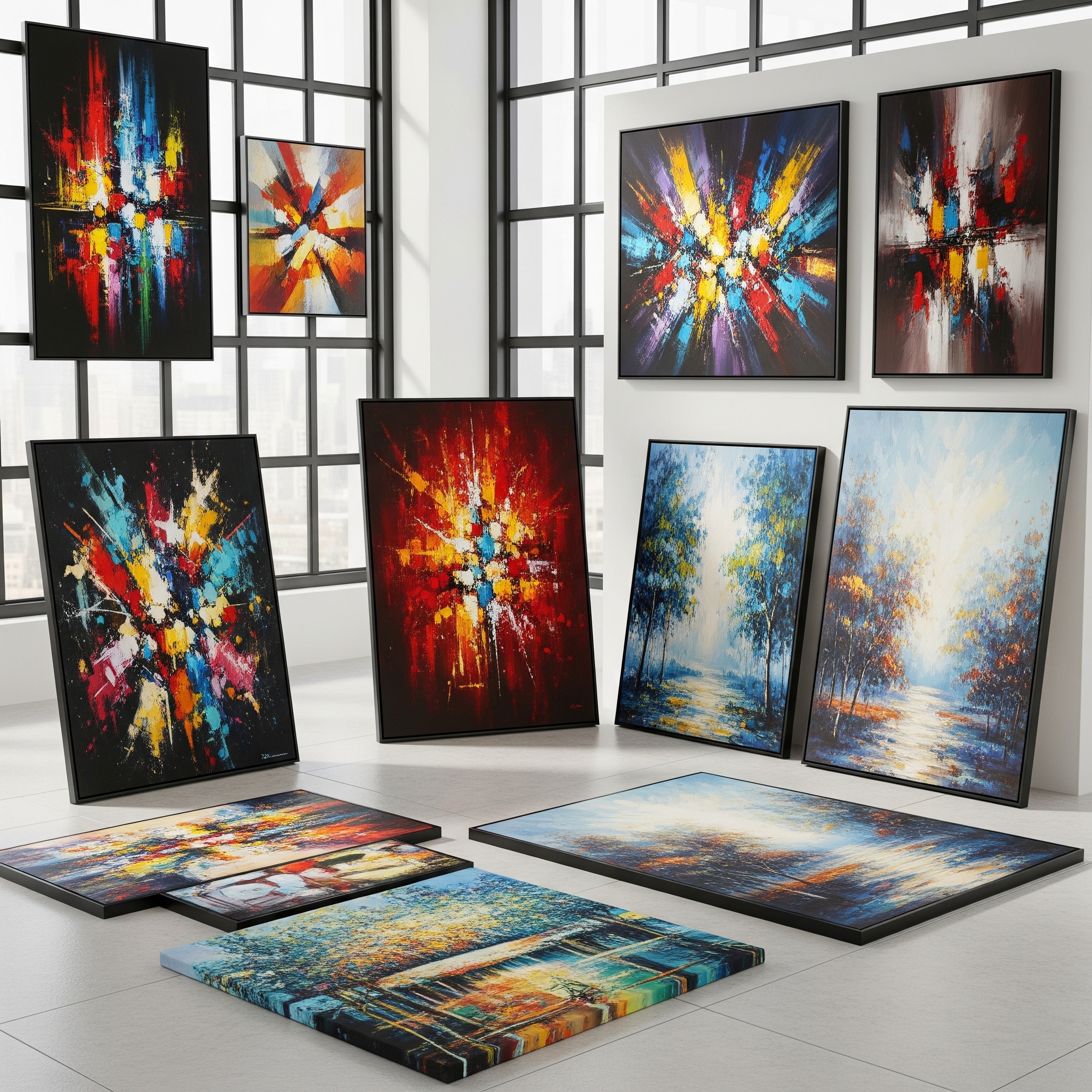Introduction: UV vs. Pigment Ink for Poster Printing – Decoding the Difference
When commissioning posters, particularly those intended for artistic display or photographic reproduction, discerning clients often notice variations in the final product depending on the printing technology used. While both Ultraviolet (UV) printing and aqueous pigment inkjet printing are capable digital methods for producing posters, the results can exhibit surprising differences in look, feel, and performance. A common observation is that pigment-based prints often appear superior for high-fidelity images, possessing a certain depth and smoothness, whereas UV prints are frequently lauded for their robustness and ability to adhere to diverse surfaces. This raises a crucial question for anyone ordering posters: Why do these differences exist, and which technology is truly better suited for a specific need?
This article delves into the fundamental distinctions between UV printing and aqueous pigment inkjet printing, two prominent technologies shaping the landscape of digital poster production. UV printing relies on specialized inks that are instantly hardened, or ‘cured’, by exposure to ultraviolet light. In contrast, aqueous pigment inkjet printing employs water-based inks containing microscopic solid color particles, which dry primarily through evaporation and absorption into the substrate.
The objective here is to provide a clear, comprehensive comparison, exploring the underlying mechanisms, ink characteristics, resulting print quality, durability factors, and material compatibility of each method. By understanding the ‘how’ and ‘why’ behind their respective outputs, readers associated with blog.printposterts.in—be they designers, artists, businesses, or hobbyists—can make more informed decisions. This analysis aims to clarify why pigment printing often yields preferred results for gallery-worthy art or photographic posters, while simultaneously acknowledging the significant advantages UV printing offers in terms of resilience and versatility for applications like durable signage or printing on unconventional materials. The following sections will examine each technology individually before undertaking a direct comparison of their quality attributes, longevity, and suitability for various poster applications, ultimately guiding readers toward the optimal choice for their projects.
Decoding UV Printing: Instant Cure, Lasting Impact
UV printing represents a significant advancement in digital printing, distinguished by its unique ink curing process that offers speed, durability, and remarkable substrate flexibility. Understanding its core principles is essential to appreciating its strengths and limitations.
The Core Process: Light-Speed Solidification
The UV printing process begins similarly to other inkjet methods: high-precision printheads, often employing piezo technology , jet droplets of specialized UV-curable ink onto the target material, known as the substrate. The critical difference occurs immediately after the ink lands. Positioned alongside or behind the printhead carriage, high-intensity UV lamps follow closely, bathing the freshly deposited ink in ultraviolet light. These lamps can be traditional mercury vapor types, which emit a broad UV spectrum, or more modern, energy-efficient UV-LEDs (Light Emitting Diodes) that produce focused light at specific wavelengths.
This exposure to UV light is not for drying in the conventional sense (i.e., evaporation), but rather initiates a rapid chemical reaction within the ink known as photopolymerization. Specialized components in the ink absorb the UV energy, triggering a chain reaction that causes the liquid ink to solidify, or ‘cure’, almost instantaneously. This immediate transition from liquid to solid eliminates the need for drying time, a major bottleneck in many traditional printing processes. The result is a hardened layer of ink bonded strongly to the substrate’s surface.
UV Ink Explained – The Science Behind the Cure
The unique properties of UV printing stem directly from the sophisticated formulation of its inks. Unlike conventional water-based or solvent-based inks, UV inks are typically 100% solids or have very low solvent content and rely on a chemical reaction for solidification. The primary components include :
- Monomers: These are small, relatively low-viscosity molecules that act partly as the liquid carrier, helping to control the ink’s flow properties (viscosity). During curing, they react and link together to form part of the solid ink film, influencing characteristics like hardness, flexibility, and adhesion.
- Oligomers: These are larger molecules, often pre-polymers or reactive resins. They form the backbone of the cured ink film and contribute significantly to its final physical properties, such as chemical resistance, abrasion resistance, and adhesion to the substrate. Oligomers generally have higher viscosity than monomers.
- Photoinitiators: These compounds are the catalysts for the curing process. They absorb specific wavelengths of UV light, break down, and generate reactive species (like free radicals) that initiate the polymerization chain reaction, linking the monomers and oligomers together into a crosslinked network. The choice and concentration of photoinitiators are critical for cure speed and efficiency.
- Pigments: Similar to other high-quality printing inks, UV inks use finely milled solid particles to provide color. These pigments must be dispersed effectively within the monomer/oligomer base.
- Additives: Various other substances are included to fine-tune performance. These can include surfactants to control surface tension and wetting, stabilizers to enhance shelf life, and crucially, adhesion promoters designed to improve the bond between the cured ink and challenging substrates, particularly those with low surface energy.
The fundamental outcome of this process is that the cured UV ink forms a distinct, durable layer that sits on top of the substrate surface. It does not rely on being absorbed into the material, which is a key difference compared to traditional aqueous or solvent inks. This surface-level characteristic is directly responsible for many of UV printing’s defining traits, including its feel and its interaction with different materials. The instant solidification prevents the ink dots from spreading excessively, contributing to sharp image definition.
Typical Applications & Strengths
The unique curing mechanism and ink formulation grant UV printing exceptional versatility. Its ability to adhere to a wide range of surfaces, including those that are non-porous or rigid, is a major advantage. Common applications include:
- Signage: Both indoor and durable outdoor signs, banners, and displays benefit from UV ink’s weather and fade resistance.
- Promotional Products: Printing directly onto items like pens, golf balls, phone cases, USB drives, and keyrings.
- Packaging and Labels: High-quality graphics directly onto cardboard, plastic containers, glass bottles, and flexible packaging films. UV printing can also create tactile effects like raised text or textures.
- Industrial Applications: Marking on metal nameplates, equipment labels, and automotive dashboards where durability is essential.
- Direct-to-Object Printing: Flatbed UV printers allow printing directly onto thicker materials and three-dimensional objects like wood panels, ceramic tiles, glass sheets, and even pre-assembled products.
Beyond versatility and durability, UV printing is often highlighted for its environmental benefits compared to traditional solvent-based printing. UV inks contain few or no volatile organic compounds (VOCs), which are harmful air pollutants released during the evaporation of solvent inks. The instant curing process, especially with energy-efficient UV-LED lamps, can also consume less energy than thermal drying methods.
The way UV ink solidifies instantly upon exposure to UV light fundamentally shapes the print’s physical nature. Because the transformation from liquid to solid happens before the ink has a chance to significantly penetrate porous materials or spread uncontrollably , it creates a tangible layer resting on the substrate’s surface. This is quite different from inks designed to soak into the material. This surface layer is the source of the slight texture sometimes felt on UV prints and influences how light reflects off the image, contributing to visual differences when compared side-by-side with prints made using absorptive ink technologies.
Furthermore, UV printing’s remarkable ability to print on almost anything stems directly from this surface-curing mechanism. Traditional water-based inks need porous materials or special coatings to absorb the liquid carrier. UV inks bypass this requirement entirely; the chemical curing happens on contact with UV light, regardless of the substrate’s absorbency. The ink’s formulation, particularly the oligomers and specialized adhesion promoters , is engineered to create a strong chemical bond between this cured layer and diverse surfaces, including challenging ones like glass, metal, and various plastics. This independence from substrate absorption is the core reason for its celebrated material versatility. However, the very existence and necessity of adhesion promoters for certain materials underscores that UV ink adhesion is a surface-bonding event, not an absorption one. Achieving a durable bond depends on favorable chemical interactions at the ink-substrate interface, which sometimes require chemical assistance, unlike aqueous inks where physical absorption into fibers plays a key anchoring role.
Understanding Aqueous Pigment Inkjet: The Choice for Detail and Depth
Aqueous pigment inkjet printing has become a cornerstone technology for applications demanding high image fidelity, particularly in fine art and photographic reproduction on traditional media like paper and canvas. Its process and ink chemistry are tailored for achieving nuanced color and detail.
The Core Process: Precision Droplets and Controlled Absorption
Aqueous pigment inkjet printers typically operate using drop-on-demand (DOD) technology. This means the printhead ejects tiny ink droplets only when and where needed to form the image. Two main DOD mechanisms exist: Thermal Inkjet (TIJ), often called bubble jet, uses a heating element to vaporize a tiny amount of ink, creating a bubble that forces a droplet out of the nozzle; Piezoelectric inkjet uses a ceramic element that flexes when voltage is applied, squeezing a droplet out. Both methods allow for precise placement of very small droplets.
When these droplets of aqueous pigment ink land on the substrate (typically paper or canvas), the process differs significantly from UV printing. The ink consists of solid pigment particles suspended in a liquid carrier, which is primarily water. On porous materials like uncoated paper, the water carrier tends to penetrate the fibers, carrying some smaller pigment particles with it, while larger particles and binders remain closer to the surface. On specially coated inkjet papers (like photo papers), the coating is designed to rapidly absorb the water carrier while keeping the pigment particles precisely positioned at or very near the surface, maximizing color density and preventing excessive spread. Drying occurs through a combination of this absorption and the evaporation of the water carrier into the air, sometimes assisted by gentle heat or airflow in high-speed systems.
Aqueous Pigment Ink Explained – Tiny Particles, Big Impact
The performance of aqueous pigment printing hinges on the careful formulation of its water-based inks. Key components include:
- Pigments: These are the colorants – microscopic, solid particles of organic or inorganic material that are insoluble in the water carrier. Achieving the desired color strength, lightfastness, and stability requires pigments milled to very fine and consistent particle sizes (often in the range of 50-200 nanometers ).
- Aqueous Carrier: Primarily purified water, which makes the inks generally eco-friendly and low-odor. It often includes co-solvents, such as glycols or other humectants, to help control drying time, adjust viscosity for proper jetting, prevent the ink from drying in the printhead nozzles, and improve interaction with the substrate.
- Dispersants, Binders, and Resins: Since pigment particles are insoluble solids, they tend to clump together (agglomerate) and settle out of the liquid carrier over time. To prevent this and ensure a stable, consistent ink, dispersants are crucial. These are typically polymeric molecules that attach to the pigment surfaces, keeping them separated and suspended (a state known as colloidal stability). Binders or resins are also included; these polymers help bind the pigment particles to each other and to the substrate surface once the water evaporates, contributing to the print’s durability and water resistance. Patent literature reveals various chemistries used, including alkali-soluble resins , polymer emulsions , and block copolymers.
- Other Additives: Small amounts of other chemicals may be added, such as surfactants to control how the ink wets the substrate surface, biocides to prevent bacterial or fungal growth in the water-based ink during storage, and sequestering agents to manage impurities.
It’s important to distinguish pigment inks from their predecessors, dye-based inks. Dyes are colorants that dissolve completely in the liquid carrier, forming a true solution. While often capable of producing very vibrant colors initially, dyes are generally less resistant to fading from light exposure (poor lightfastness) and can bleed or run if the print gets wet because the dye molecules remain water-soluble. The insolubility of pigment particles is the primary reason pigment inks offer significantly better archival properties (lightfastness) and water resistance.
Typical Applications & Strengths
Given their formulation and interaction with substrates, aqueous pigment inks are primarily used for printing on materials that can manage the water carrier effectively, namely porous or specially coated media. Their strengths align well with applications where image quality and longevity on these materials are paramount:
- Fine Art Reproduction (Giclée): The ability to produce prints with wide color gamuts, smooth tonal transitions, and excellent longevity makes pigment inks the standard for high-quality art reproductions on archival papers and canvas.
- Photographic Printing: Widely used by professional photographers and labs for high-quality photo prints on various paper finishes (glossy, luster, matte) offering vibrant colors and long-term stability.
- High-Quality Indoor Graphics: Posters, point-of-sale displays, and other indoor graphics where color accuracy and print quality are important.
- Proofing: Used in the commercial print industry for creating color-accurate proofs before final press runs.
- Document Printing: High-end office printers may use pigment black ink for sharp, durable text.
Key advantages often cited for aqueous pigment printing include potentially superior color fidelity and gamut achievable on optimized media , the ability to achieve a very smooth, non-textured finish preferred for photos and art , excellent archival lightfastness , and the environmental benefit of using water as the primary solvent. Furthermore, the entry cost for high-quality aqueous pigment printers can be lower than for comparable UV systems.
The final appearance and quality of an aqueous pigment print are profoundly influenced by the synergy between the ink and the substrate. Pigment particles must remain close to the surface to yield the best color saturation and sharpness. If printed on highly absorbent, uncoated paper, the ink vehicle can wick too deeply into the fibers, potentially causing feathering, reducing color density, and making the image appear less vibrant. Conversely, specialized inkjet coatings on photo and fine art papers are engineered with microscopic pores designed to rapidly draw the water carrier away while immobilizing the pigment particles precisely at the surface. This controlled interaction is far more critical for achieving optimal results than in UV printing, where the ink essentially creates its own surface layer independent of substrate absorption.
Maintaining the stability and performance of pigment inks presents significant formulation challenges. Because pigments are solid particles that do not dissolve , preventing them from settling out or clumping together over time requires sophisticated dispersant chemistry. Ensuring these microscopic particles remain evenly suspended at consistent sizes is vital not only for color consistency but also for reliable printer operation, as larger agglomerates can clog the tiny nozzles in the printhead. Ink formulators must carefully balance the pigment concentration (needed for strong colors) against the need for low viscosity to allow the ink to be reliably jetted through the printhead nozzles. This inherent chemical complexity in managing suspensions contrasts with the challenges in UV ink formulation, which revolve more around controlling the reactivity and viscosity of the monomers and oligomers.
The historical progression of inkjet technology also sheds light on pigment’s current role. Early inkjet printers predominantly used dye-based inks, prized for their brightness but plagued by issues of fading and poor water resistance. The development and adoption of pigment-based aqueous inks represented a major leap forward in print permanence, offering dramatic improvements in both lightfastness and resistance to moisture. This enhanced durability opened the door for inkjet printing to be seriously considered for archival applications, such as museum-quality fine art prints and long-lasting photographic displays. Consequently, aqueous pigment ink became the benchmark for high-quality, durable printing within the realm of paper and canvas media, establishing its reputation as the preferred choice for these specific applications.
Comparing the Contenders: Print Quality Showdown
When evaluating UV and aqueous pigment printing for posters, particularly those featuring photography or fine art, the nuances of print quality become paramount. Differences in color performance, detail rendition, sharpness, and surface texture significantly impact the final aesthetic and suitability for specific purposes.
Color Performance: Gamut, Vibrancy, and Accuracy
- UV Printing: UV inks can produce sharp graphics with strong, vibrant colors. Because the ink cures instantly on the surface without significant absorption into the substrate, color saturation tends to be high. Modern UV printers can achieve good color gamuts. Additionally, UV printing offers the ability to control the final gloss level, allowing for matte or glossy finishes, and even the application of a clear varnish for spot effects or overall protection. However, the inherent nature of the cured ink layer sitting atop the substrate can sometimes influence the perception of color compared to inks integrated into paper.
- Aqueous Pigment Printing: This technology is renowned for its potential to achieve excellent color reproduction, particularly wide color gamuts, when paired with appropriate high-quality coated or fine art papers. Professional photo and fine art printers often utilize expanded ink sets with six or more colors, including light cyan, light magenta, various shades of black and gray, and sometimes additional colors like orange, green, or violet. These extra inks help to expand the achievable gamut, improve the smoothness of tonal transitions (especially in skin tones and skies), and enhance black and white printing accuracy. The perceived vibrancy can be exceptionally high, especially on glossy or luster finish papers. Color accuracy is a key strength, critical for faithful reproduction of photographs and artwork.
- Comparison: For applications demanding the most nuanced and accurate color reproduction, such as gallery-quality art or professional photography posters printed on specialized papers, aqueous pigment printing is often considered superior. Its ability to render subtle gradients and achieve wide gamuts optimized for paper media is a distinct advantage. UV printing delivers strong, impactful color directly onto a wider variety of materials , but the final appearance, influenced by the surface ink layer, might lack the delicate tonal variations and integrated smoothness highly valued in traditional fine art contexts.
Detail, Sharpness, and Texture
- UV Printing: The near-instantaneous curing of UV ink significantly minimizes dot gain – the tendency for ink droplets to spread outwards after hitting the substrate. This physical limitation on spread can result in very sharp edges and fine details being rendered crisply. However, a defining characteristic of UV printing is that the cured ink forms a tangible layer on the substrate surface. This layer can sometimes possess a slight texture or feel slightly raised, particularly in areas with heavy ink coverage (dark colors). While sometimes desirable for specific effects, this physical texture can potentially interfere with the perception of ultra-fine details or create a surface appearance different from traditional prints.
- Aqueous Pigment Printing: When used with appropriate smooth, coated papers designed to control ink absorption and spread, pigment inkjet printers can achieve extremely high resolution and sharpness. The ink tends to integrate more seamlessly with the paper surface, typically resulting in a much flatter, less textured finish compared to UV prints. While dot gain can be a factor, especially on more porous or lower-quality papers , high-quality inkjet media are specifically engineered to minimize this and allow for sharp detail rendition.
- Comparison: The assessment of sharpness and detail involves a trade-off. UV printing offers excellent edge sharpness due to its inherent low dot gain resulting from instant curing. However, the physical presence of the ink layer on the surface can introduce a texture that may be undesirable for applications striving for the smooth, integrated look of traditional photographs or fine art prints. Aqueous pigment printing, on the right media, provides that smooth, non-textured finish along with excellent fine detail resolution , making it the preferred choice when surface smoothness and seamless integration of the image with the substrate are critical.
The often-noted difference in perceived “quality” for fine art and photographic posters frequently hinges on the physical nature of the print surface itself – the presence or absence of texture – perhaps even more than subtle differences in color gamut or raw resolution. UV ink solidifies into a distinct, almost plastic-like layer resting on top of the poster material. This can impart a slight physical relief or a different surface sheen that deviates from the expected look and feel of traditional prints produced on paper or canvas. Aqueous pigment inks, conversely, work by having the pigment particles bind within the paper’s surface fibers or specialized coating layer after the water carrier is absorbed. This results in a more integrated, smoother finish – whether matte, luster, or gloss – that aligns closely with established aesthetic expectations for high-quality reproductions. This tactile and visual smoothness contributes significantly to why pigment prints are often perceived as having higher fidelity in these specific contexts.
Although both technologies utilize pigments as colorants, the fundamental difference in their delivery systems—UV-curable liquids versus a water-based carrier—and their subsequent interaction with the substrate profoundly alters the final visual presentation. In UV printing, the pigment becomes encapsulated within a solid polymer matrix sitting on the surface. Light interacts with this surface layer in one way. In pigment printing, light interacts with pigment particles nestled near the surface of paper fibers or held within a receptive coating. This difference in how light reflects and scatters can affect the perceived depth, richness of tones, and overall subtlety of the image, potentially explaining why pigment prints on quality paper might appear to have more ‘depth’ or nuance to some viewers. Furthermore, the technical requirements for formulating inks – ensuring low viscosity and rapid curing for UV , versus managing pigment dispersion and water interaction for aqueous – may lead to different choices or constraints regarding pigment types, particle sizes, or concentrations optimized for each system, further influencing the final color appearance.
Consequently, the concept of “sharpness” itself can be interpreted differently. UV printing’s sharpness is often defined by its excellent edge acuity, a direct result of the minimal ink spread allowed by the instant cure. Aqueous pigment printing’s perceived sharpness, when executed on high-quality media, benefits not only from precisely controlled dot placement but also from the smooth, non-textured integration of the ink with the surface. This lack of a raised ink layer may allow the human eye to perceive fine details more naturally and without the potential micro-distractions caused by the physical relief of a UV ink layer , even if the underlying dot placement accuracy is comparable.
Comparing the Contenders: Built to Last? Durability Face-Off
Beyond initial appearance, the longevity and resilience of a poster are critical considerations, especially for commercial use or long-term display. UV and aqueous pigment printing exhibit distinct durability profiles.
Fade Resistance (Lightfastness)
- UV Printing: The cured UV ink layer forms a robust, crosslinked polymer matrix that generally offers good to excellent resistance to fading caused by exposure to light, including UV radiation. This inherent stability makes UV prints suitable for applications with significant light exposure, such as outdoor signage.
- Aqueous Pigment Printing: Modern pigment inks are specifically engineered for superior lightfastness, representing a major advancement over older dye-based inks. High-quality pigment prints on archival media are often rated to last for many decades, or even centuries, without significant fading when displayed indoors under typical lighting conditions. This makes them the standard choice for archival fine art and photographic prints.
- Comparison: Both technologies provide strong resistance to fading. Aqueous pigment inks have a well-established track record and industry acceptance for exceptional archival longevity, particularly for indoor fine art and photographic applications. UV printing, while also offering very good lightfastness, is particularly proven in demanding outdoor environments where factors beyond light (like weather) are also at play. For most indoor poster applications, both technologies likely offer more than sufficient fade resistance.
Resistance to Elements: Water, Scratch, and Abrasion
- UV Printing: The cured UV ink layer is inherently hard and durable. It forms a non-porous, plastic-like surface that is highly resistant to water, chemicals, scratching, and general abrasion. This robustness often means that UV prints do not require additional protective lamination, even for demanding applications.
- Aqueous Pigment Printing: Because the pigment particles themselves are solid and water-insoluble, pigment prints exhibit significantly better water resistance than dye-based prints. Once dry, they generally do not smudge easily when exposed to moisture. However, the overall physical durability is still largely dependent on the substrate (paper or canvas) and the binders in the ink formulation. The print surface can remain susceptible to scratching or scuffing, especially on uncoated papers. While water-resistant, prolonged soaking or rubbing when wet might still affect the print or substrate integrity depending on the specific paper and ink combination.
- Comparison: UV printing offers demonstrably superior physical durability straight from the printer. Its resistance to water, scratches, and abrasion is inherent to the cured ink layer itself. Aqueous pigment prints provide good water resistance compared to dyes , but achieving a similar level of protection against physical scratching and abrasion typically requires the application of a protective overlaminate or coating, particularly for posters intended for high-traffic areas, frequent handling, or outdoor exposure.
The nature of durability offered by each technology differs significantly. UV printing excels in providing immediate physical robustness – resistance to handling, moisture, and surface damage – thanks to its tough, cured polymer layer. Aqueous pigment printing’s strength lies more in archival permanence, particularly its exceptional lightfastness ensuring color stability over very long periods indoors , coupled with good water resistance owing to the pigment’s insolubility. However, the underlying paper or canvas substrate remains inherently more vulnerable to physical wear and tear compared to the resilient UV ink surface, unless an additional protective layer is applied. This fundamental difference explains the typical application divergence: UV for physically demanding scenarios (outdoors, high-touch surfaces), and pigment for preserved indoor displays where image fidelity and archival stability are key.
Consequently, the potential need to laminate aqueous pigment prints to achieve maximum physical durability introduces an additional step and associated costs (materials and labor). While the initial cost of a pigment printer might be lower , if the final poster application demands high resistance to scratches, scuffs, or frequent cleaning, the total cost of producing a laminated pigment print could become comparable to, or even exceed, that of an inherently durable UV print, for which lamination is often unnecessary. This makes UV printing a more cost-effective and efficient solution for applications where high physical robustness is a primary requirement.
Comparing the Contenders: What Can They Print On? Substrate Versatility
A major point of differentiation between UV and aqueous pigment printing lies in the range of materials each technology can successfully print on. This factor heavily influences the types of posters and printed products that can be created.
UV Printing
UV printing technology is celebrated for its extraordinary substrate versatility. Because the ink cures chemically on the surface via UV light exposure rather than relying on absorption, it can adhere to a vast spectrum of materials, including:
- Rigid Materials: Plastics (like PVC, acrylic, polycarbonate, polystyrene), wood, glass, metal (aluminum, steel), ceramic tiles, foam board, composite panels (like Dibond). Flatbed UV printers are specifically designed to handle these thick, rigid sheets.
- Flexible Materials: Paper, cardboard, vinyl banner material, flexible plastics, synthetic papers, canvas, leather, textiles, foil. Roll-to-roll UV printers handle flexible media.
- Non-Porous Surfaces: Materials that do not absorb liquids, such as glass, metal, and many plastics, pose no fundamental barrier to UV printing adhesion, although specialized formulations or adhesion promoters might sometimes be required for optimal results on particularly challenging surfaces like low-surface-energy plastics.
Aqueous Pigment Printing
Aqueous pigment printing is significantly more limited in its substrate compatibility. It is primarily designed for materials that can effectively manage the water-based ink carrier through absorption or interaction with a specialized receptive coating. Suitable materials generally include:
- Porous Materials: Various types of paper (plain uncoated, matte coated, fine art papers with varying textures), cardboard, and canvas designed for inkjet printing.
- Coated Materials: Glossy, luster, and satin photo papers feature specialized coatings engineered to receive aqueous inks optimally. Certain treated textiles can also be printed.
- Limitations: Standard aqueous pigment inks generally cannot adhere properly to non-porous surfaces like untreated glass, metal, or most plastics, as there is no mechanism for the ink to anchor effectively.
Comparison
The contrast is stark: UV printing offers vastly superior substrate versatility compared to aqueous pigment printing. This capability allows UV technology to produce a much wider range of printed items beyond traditional posters, including rigid signs, decorative panels, and direct prints on objects. Aqueous pigment printing remains largely confined to paper, canvas, and specifically prepared media.
The ability to print directly onto rigid, non-absorbent substrates like wood, metal, acrylic, and glass is arguably UV printing’s most significant advantage over aqueous pigment technology. This opens up entirely new possibilities for unique poster formats, signage, interior decor elements, and personalized products that are simply unattainable with standard aqueous printers. This expansive capability is a direct consequence of the surface-curing mechanism , which decouples the printing process from the need for substrate absorption.
However, when considering traditional poster materials like paper and canvas, the relationship with the substrate differs. For aqueous pigment printing, the specific choice of paper or canvas is absolutely critical to achieving high-quality results. The interaction between the ink and the media’s surface or coating dictates dot spread, color density, sharpness, and overall appearance. Using an inappropriate paper can lead to disappointing outcomes, such as muddied colors or fuzzy details. UV printing, while still influenced by the substrate’s texture and color, is generally less dependent on the specific paper type for basic ink adhesion and function, as the ink cures independently on the surface. It is, therefore, more forgiving in terms of simply getting an image onto different paper types, although achieving the desired aesthetic still requires careful media consideration.
The Verdict for Posters: Why Pigment Excels for Art, UV for Durability & Versatility
Synthesizing the comparisons across ink properties, print quality, durability, and substrate compatibility allows for a clearer understanding of why aqueous pigment printing is often preferred for certain types of posters, while UV printing excels in others. The initial query regarding why pigment prints might be considered superior for art or photo posters can now be addressed directly.
Synthesizing the “Why”: Addressing the Core Question
The perception that aqueous pigment prints often look better for high-fidelity fine art or photographic posters stems primarily from a combination of factors related to the final print’s physical characteristics and its alignment with traditional aesthetic expectations:
- Smoother, Integrated Finish: Aqueous pigment inks, when printed on appropriate media, tend to settle into the surface or coating, creating a smooth finish with minimal physical texture. The pigment particles become part of the paper’s surface layer rather than sitting entirely on top. This lack of a discernible raised ink layer closely mimics the appearance of traditional photographic prints and other fine art techniques, meeting established expectations for these applications. In contrast, the cured UV ink forms a distinct physical layer on the substrate , which can sometimes impart a slight texture or sheen that feels different and may be perceived as less refined for delicate artwork or photos.
- Optimized Ink-Media Synergy: Decades of research and development have focused on perfecting the interaction between aqueous pigment inks and specialized fine art/photographic papers and canvases. These systems are highly optimized to deliver exceptional tonal range, smooth gradients, fine detail rendition, and accurate color fidelity specifically on these types of media. The entire ecosystem—printer, ink, and paper—is often designed to work in concert for optimal results.
- Perceived Depth and Subtlety: The way light interacts with pigment particles embedded just below or at the surface of a paper substrate can differ from how it reflects off the relatively uniform, plastic-like surface of a cured UV ink layer. This difference in light interaction may contribute to a perception of greater visual depth, richer blacks, and more subtle tonal variations in high-quality pigment prints on matte or luster papers, qualities highly valued in art reproduction.
Highlighting Strengths for Specific Poster Types
Based on the analysis, clear recommendations can be made for choosing between the two technologies depending on the poster’s intended use and desired characteristics:
Choose Aqueous Pigment Printing When:
- The primary goal is achieving the highest possible fidelity for fine art or photographic reproductions intended for indoor display.
- A smooth, non-textured print finish (whether matte, luster, satin, or gloss on paper/canvas) is essential to the desired aesthetic.
- Archival lightfastness for long-term indoor preservation is a top priority.
- The project involves printing exclusively on standard poster materials like various paper types, canvas, or specific inkjet-receptive media.
Choose UV Printing When:
- Maximum physical durability is required, including high resistance to water, scratches, chemicals, and abrasion.
- The poster will be displayed outdoors or in environments with potential exposure to weather or harsh conditions.
- The poster will be placed in high-traffic areas or subject to frequent handling or cleaning.
- The project requires printing on non-traditional or rigid materials such as wood, metal, acrylic, glass, plastics, or thick boards.
- Rapid production turnaround is critical, leveraging the instant curing time.
- Creating special effects like spot varnish, textured prints (embossing), or printing white ink on colored substrates is desired.
Essential Comparison Table
To provide a quick reference, the following table summarizes the key differences discussed:
| Feature | UV Printing | Aqueous Pigment Printing |
|---|---|---|
| Ink Type | UV-curable monomers, oligomers, photoinitiators, pigments, additives | Water, co-solvents, pigments, dispersants/resins, additives |
| Curing/Drying | Instant chemical cure via UV light (photopolymerization) | Evaporation of water & absorption into substrate/coating |
| Ink Layer | Sits distinctly on top of the substrate surface | Integrates with the substrate surface/coating |
| Surface Texture | Potential for slight texture or raised feel, especially in dark areas | Generally smooth, follows substrate texture |
| Color (Fine Art Context) | Vibrant, high saturation; may lack ultimate subtlety on paper | Excellent nuance, wide gamut potential on optimized papers |
| Detail/Sharpness Perception | Excellent edge acuity (low dot gain); texture can impact perception | High resolution, smooth integration allows fine detail perception on good media |
| Lightfastness | Good to Excellent, suitable for outdoor use | Excellent, industry standard for archival indoor display |
| Water Resistance | Excellent, inherent to cured ink layer | Good (pigment insolubility); substrate may still be affected |
| Scratch/Abrasion Resistance | Excellent, very durable surface | Moderate; often requires lamination for high durability |
| Substrate Versatility | Extremely High: Rigid, flexible, porous, non-porous materials | Moderate: Primarily porous or specially coated media (paper, canvas) |
| Best For (Poster Types) | Outdoor signage, durable displays, prints on unique materials (wood, metal, plastic), high-traffic areas, fast turnaround | Indoor fine art/photo reproduction, gallery prints, applications prioritizing smooth finish & archival quality on paper/canvas |
Conclusion: Choosing the Right Ink for Your Poster Project
The choice between UV printing and aqueous pigment inkjet printing for poster production is not about determining which technology is universally superior, but rather about selecting the method best aligned with the specific requirements and intended application of the final product. Each technology offers a distinct set of advantages and trade-offs rooted in its fundamental process and ink chemistry.
Aqueous pigment inkjet printing has earned its reputation as the preferred choice for high-fidelity reproduction of fine art and photography on traditional media like paper and canvas. Its strength lies in delivering exceptional color accuracy, wide gamuts optimized for these substrates, smooth tonal gradations, and a seamless, non-textured finish that meets the aesthetic expectations for gallery-quality work. Coupled with outstanding archival lightfastness, it remains the benchmark for posters where visual nuance and long-term indoor preservation are the highest priorities.
Conversely, UV printing stands out for its remarkable durability and unparalleled substrate versatility. The instantly cured ink forms a tough, resilient layer resistant to water, scratching, and fading, making it ideal for posters destined for demanding environments, whether outdoors, in high-traffic public spaces, or requiring frequent handling. Furthermore, its ability to print directly onto an extensive range of rigid and non-porous materials—from wood and metal to plastics and glass—opens up creative possibilities far beyond the scope of traditional paper-based posters. The speed afforded by instant curing also makes it highly efficient for rapid production cycles.
Therefore, the guidance for readers of blog.printposterts.in is clear:
- For posters that aim to replicate artwork or photographs with the utmost fidelity for indoor display, where a smooth, traditional finish on paper, acrylic or canvas is desired, aqueous pigment printing is likely the optimal selection.
- For posters demanding exceptional physical robustness, resistance to environmental factors, or for projects involving printing on unconventional materials like wood, metal, or rigid plastics, UV printing provides the necessary durability and material compatibility.
Ultimately, understanding the core differences—pigment’s integration with paper for visual subtlety versus UV’s surface cure for toughness and versatility—empowers designers, artists, and businesses to make informed decisions. By carefully considering the primary function and desired aesthetic of their poster project, they can confidently choose the printing technology that will deliver the best possible results.
